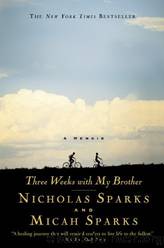Three Weeks With My Brother by Nicholas Sparks; Micah Sparks

Author:Nicholas Sparks; Micah Sparks
Language: eng
Format: mobi
Tags: United States, Brothers, Voyages and Travels, 20th Century, Foreign Countries, Novelists, Essays & Travelogues, General, Literary, Family & Relationships, Personal Memoirs, Americans, Authors, Biography & Autobiography, Siblings, American, Travel, Biography
ISBN: 9780446532440
Publisher: Hachette Digital, Inc.
Published: 1980-01-02T00:00:00+00:00
Chapter 12
Angkor, Cambodia
February 4-5
The temples at Angkor, Cambodia-an area encompassing nearly 120 square miles-were built from A.D. 879 to 1191 when the Khmer empire was at its zenith. More than a hundred temples have been discovered, and they were once surrounded by cities, from which the kings of the empire ruled over a domain that covered a vast portion of Southeast Asia, including Burma, Thailand, Laos, Vietnam, southern China, and Cambodia. Their rule lasted nearly five hundred years, until 1432, when the Siamese (Thai) sacked Angkor, and the capital was moved south to Phnom Penh. Angkor never regained its former stature, and eventually drifted into obscurity as the jungle continued its never-ending encroachment.
In time, Angkor passed into legend-people who saw the ruins claimed theyâd been built by the gods-and a few adventurous explorers from Europe circulated stories about the famous ruins among their peers. It wasnât until 1860 that the French explorer Henri Mouhot brought Angkor back to the worldâs attention.
The French were enchanted by the ruins and began an extensive restoration effort. Yet all that remained of Angkor were the temples themselves, which are regarded as one of mankindâs greatest architectural achievements. The cities, whose buildings were constructed of wood, had long since decayed and vanished into the surrounding jungle.
The vast majority of the temples in the Angkor region are Hindu in influence; the remainder are Buddhist. At the time of their construction, both belief systems were prevalent in the empire, and as rulers came and went-Buddhists replaced by Hindus, and vice versa-temples were constructed to reflect the changing times. Still, the architecture varied only slightly; most contained a temple-mountain-like structure in the center, surrounded by square or circular walls or platforms, and enclosed within either a moat or perimeter wall.
Angkor Wat, literally âCity Temple,â is not only the largest temple in the Angkor complex, but the largest religious monument in existence. Constructed during the first half of the twelfth century by Suryavaram II, itâs regarded as the high point of Khmer architecture.
The carvings on the outer walls depict important scenes from Hindu literature, as well as events from the reign of Suryavarman II, in exacting, intricate detail. To study and fully understand the relief carvings-on walls twelve feet high and spanning over a kilometer in length-would take years. Entire books have been written on the subject of the carvings alone, and itâs far beyond the scope of this volume to even attempt to comment on them.
As they say, you must see it to believe it.
The flight to Cambodia was another seven hours, and I began to grasp what a feat traveling around the world really was. In the end, we would fly 36,000 miles and spend nearly three full days in the air.
I wasnât sure what to expect when I reached Cambodia. Though Iâd traveled to Hong Kong and Korea for track competitions, I wasnât prepared for the city of Phnom Penh when we landed. In a strange way, the land struck me as being both hopeful and tragic.
Download
This site does not store any files on its server. We only index and link to content provided by other sites. Please contact the content providers to delete copyright contents if any and email us, we'll remove relevant links or contents immediately.
Blood and Oil by Bradley Hope(1246)
Daniel Holmes: A Memoir From Malta's Prison: From a cage, on a rock, in a puddle... by Daniel Holmes(1117)
Ambition and Desire: The Dangerous Life of Josephine Bonaparte by Kate Williams(1084)
Wandering in Strange Lands by Morgan Jerkins(1014)
It Was All a Lie by Stuart Stevens;(940)
What Really Happened: The Death of Hitler by Robert J. Hutchinson(868)
London in the Twentieth Century by Jerry White(844)
Time of the Magicians by Wolfram Eilenberger(842)
The First Conspiracy by Brad Meltzer & Josh Mensch(811)
Twilight of the Gods by Ian W. Toll(811)
A Woman by Sibilla Aleramo(796)
The Japanese by Christopher Harding(795)
Lenin: A Biography by Robert Service(778)
The Devil You Know by Charles M. Blow(777)
Reading for Life by Philip Davis(774)
Cleopatra by Alberto Angela(764)
Twelve Caesars by Mary Beard(764)
1965--The Most Revolutionary Year in Music by Andrew Grant Jackson(714)
The Life of William Faulkner by Carl Rollyson(713)
